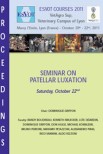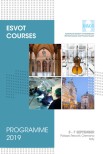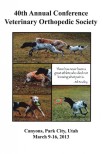Objective: The aim of this study was to ascertain whether a prosthetic meniscus adapts pressures to native tibial contact pressures in a canine stifle joint after total medial meniscectomy.
Study design: Ex vivo biomechanical experimental study.
Sample population: Seven cadaveric hindlimbs of seven large-breed dogs.
Methods: Cadaveric canine stifles were loaded vertically at 135° of flexion. The peak pressure (PP), mean pressure (MP), and contact area (CA) on the medial and lateral tibial plateaus were measured for the intact stifle, after medial meniscectomy and after implantation of the prosthetic meniscus. Comparisons were made between same parameters in varying conditions, but not in varying compartments.
Results: Mean PP and MP increased significantly after medial meniscectomy (6.1 and 2.3 MPa, respectively) relative to those of the native stifle joint (3.5 and 1.0 MPa, respectively), whereas meniscectomy resulted in significantly lower mean CA on the medial tibial plateau (65 mm2) compared to the native stifle joint (170 mm2). The prosthetic meniscus significantly decreased PP to 3.3 MPa and MP to 1.0 MPa and significantly increased CA to 96 mm2 relative to the meniscectomized stifle. PP and MP were not statistically different between the native stifle and prosthetic meniscus.
Conclusion: The prosthetic meniscus significantly restored tibial contact pressures to normal (native) values in the meniscectomized canine stifle.
Clinical significance: A prosthetic meniscus has the potential to restore biomechanical function in the canine stifle with an impaired medial meniscal function.









